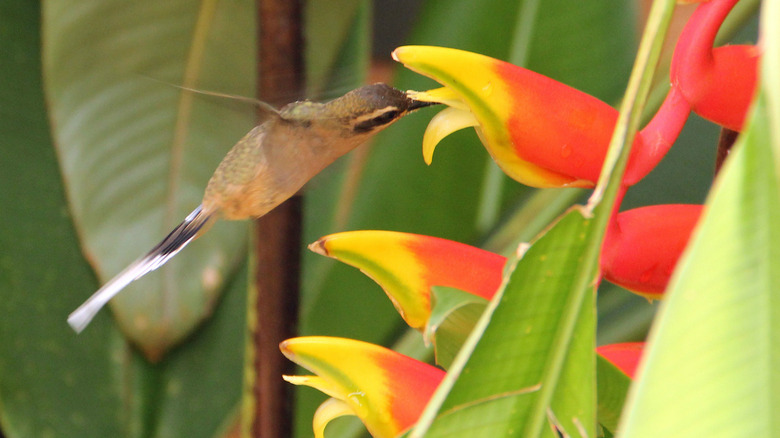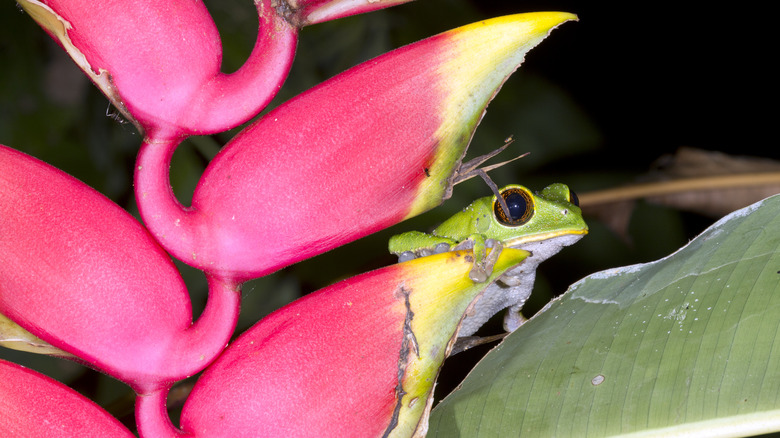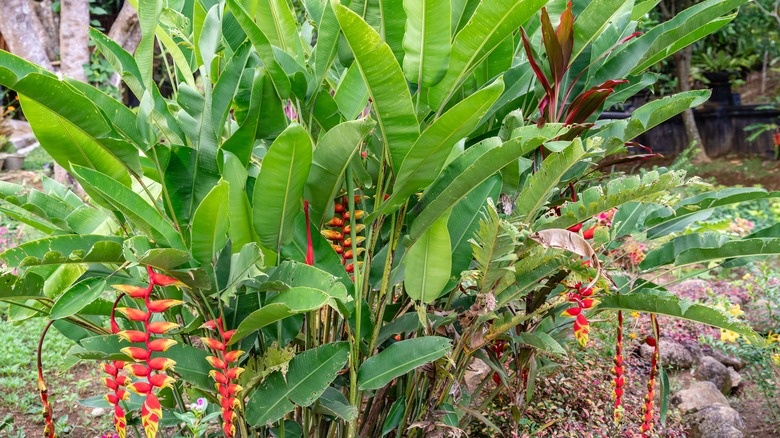The Hummingbird-Attracting Benefits Of Growing Lobster Claw Plants In Your Yard
Transport yourself to the tropics right in your own garden with the eye-catching lobster claw plant. Also known as Heliconia rostrata and false bird of paradise, this flashy warm-climate dweller can lure hummingbirds to your yard in USDA Zones as low as 4a if you provide the right patio conditions. Lobster claw plants show off red bracts tipped in yellow, the perfect color you should add to your garden to help attract hummingbirds. Bracts are leaf structures at the base of a plant's flowers, and lobster claws' bracts are packed with tasty blooms that hummingbirds love.
Heliconia rostrata are natives of Bolivia, Colombia, Ecuador, and Peru, and can grow beautifully year-round in parts of Hawaii and southern Florida. If you live in a chillier climate, lobster claw plants can still attend your summer garden party. Living in a pot, Heliconia rostrata can come inside and out according to the weather's whims, allowing its long-lasting bracts to nourish hummingbirds as far north as southern Alaska. According to Oxford University, Heliconia rostrata tolerates colder temperatures more than other similar plants. Inviting a lobster claw plant to your garden or patio this summer is a treat for your senses as well as for hummingbirds and other pollinators.
The benefits of growing lobster claw plants
Dramatic Heliconia rostrata is an attention-grabbing plant that is a joy to watch grow. Reaching heights of up to 5 feet and buzzing with pollinators, lobster claw plants put on a daily show for you. They bloom for extended periods of time, giving hummingbirds a reliable source of nectar throughout the season. However, your enjoyment isn't the only good thing that comes from planting a lobster claw plant.
Not only are these flowers a magnet for hummingbirds, they are a great plant for your pollinator garden. Hungry creatures from bats to bugs feast on its nectar. Lobster claw plants can be a habitat for insects and even frogs who live in water that collects in the bracts. Attracting these helpers to your garden is great for your plants, but it also gives a boost to threatened insects like honey bees and solitary bees. With habitat loss and other environmental threats, providing bee species additional food sources is a responsible way to help protect biodiversity.
How to grow and care for your lobster claw plant
A healthy and robust Heliconia rostrata can grow up to 5 feet tall with vibrant bracts that can stretch from 6 to 8 inches in length. In all but the warmest reaches of the U.S., a lobster claw plant will fare best in a pot as part of a flower garden on your patio. Unless you live in USDA zones 10 or 11, plant Heliconia rostrata in containers that you bring inside when temperatures dip. Place Heliconia rostrata in areas that get partial shade for best results.
Lobster claw plants thrive in moist, fertile soil and can tolerate a variety of textures, from sand to loam to clay. They are slightly drought-tolerant, but ensure your plant's health by keeping the soil moist and well-fertilized. They prefer humidity, and some experts don't recommend growing Heliconia rostrata in dry regions. Lobster claws are very nutrient-hungry and require frequent fertilization throughout the growing season.


